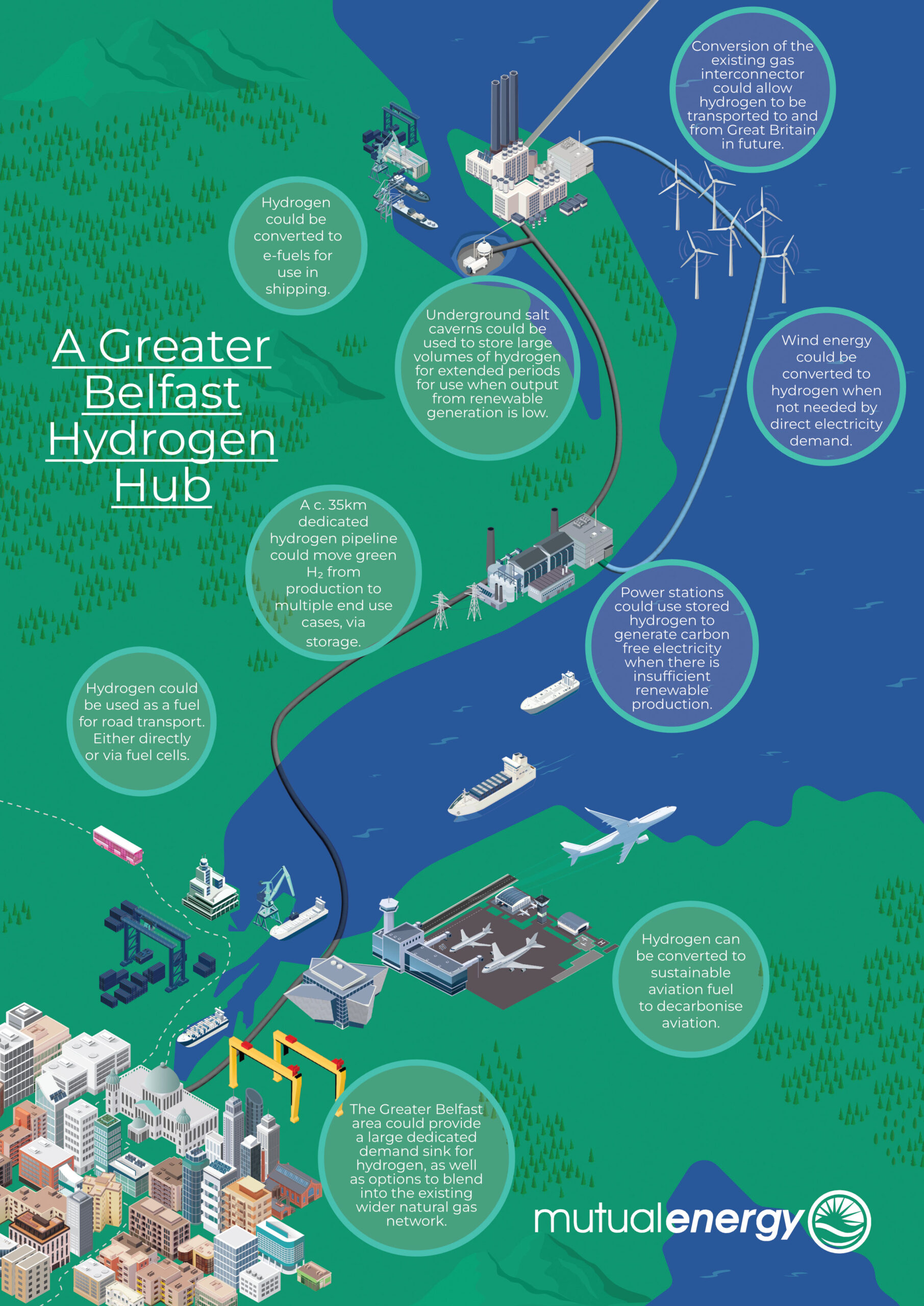Green hydrogen a ‘golden ticket’ towards net zero goals

Mark Alexander, Energy Transition Manager at Mutual Energy, outlines the role of renewable gases and energy storage in meeting net zero emissions targets.
Northern Ireland is a renewable energy success story. Over the last 15 years, world leading levels of renewable energy have been integrated onto the electricity grid, and currently over 40 per cent of all electricity consumed in Northern Ireland is renewable. However, despite this progress, the reality is that we need to do more if Northern Ireland is to meet its net zero emissions targets.
The gas network currently ensures security of energy supply in Northern Ireland, providing on-demand access to natural gas to heat homes and businesses, as well as fuel for power stations to balance the electricity grid. Carbon emissions from natural gas must be phased out by 2050, so how will we ensure we have a secure and reliable energy system? It will take a lot more than simply increasing renewable electricity generation capacity.
The need for renewable gases
Northern Ireland is lucky. We have favourable conditions for production of renewable gases like biomethane, generated from agricultural byproducts, and green hydrogen, produced by splitting water molecules using renewable electricity. Renewable gases offer us the opportunity to deliver decarbonisation and move away from fossil fuels while maintaining the flexibility and security of supply currently provided by natural gas.
With a large agricultural sector, there is a ready-made supply of feedstocks for biomethane production in Northern Ireland and already progress is being made to get this renewable gas on to the gas network. Green hydrogen offers another exciting opportunity and could play a key role in decarbonising our energy supply, as well as addressing wider energy storage needs.
Our difficulty is not so much the production of sufficient renewable energy per se, but matching its generation with electricity demand at any given time. How do we deal with the problem of increasing renewable energy curtailment, when there is too much renewable energy? Equally, where does our renewable energy come from when it is not windy, or the sun does not shine?
“Developing a Green Hydrogen Hub could help manage renewable oversupply, ‘kick start’ e-fuel production in Northern Ireland, reduce emissions from dispatchable power generation, while also supporting wider decarbonisation of transport and heat sectors.”
Energy storage
The answer is energy storage – capturing surplus renewable energy and storing it for use when the output from wind and solar generation is not sufficient to meet demand. The concept is straightforward but its implementation at the scale required to decarbonise the energy system is not. This is where green hydrogen comes in. Renewable electricity via electrolysis can split water into its constituent elements of hydrogen and oxygen. The hydrogen can then be stored at scale over long periods of time and used as a decarbonised fuel source for controllable electricity generation during periods of low renewable output, replacing natural gas.
|
Five key steps to cashing in Northern Ireland’s ‘golden ticket’: 1. Prioritise energy storage |
With strong renewable generation potential from onshore and offshore wind, and unique local geology to support development of large-scale salt cavern storage close to Greater Belfast, Northern Ireland has a ‘golden ticket’ to develop a fully circular green hydrogen economy. However, to date a lack of progress on policy and infrastructure development has prevented us from realising this potential.
Green Hydrogen Hub
Given the right policy support, Northern Ireland could develop a ‘hydrogen hub’ in the Greater Belfast area. Offshore wind farms are expected to connect to the onshore grid near existing power stations at Ballylumford and Kilroot. Large-scale, centralised, electrolytic green hydrogen production could be sited close to salt cavern storage. With a pipeline of around 35km this hydrogen network could help facilitate and support decarbonisation of the Greater Belfast conurbation, including two out of three of Northern Ireland’s existing gas-fired power stations, as well as Larne and Belfast ports, potentially helping to decarbonise shipping.
Developing a Green Hydrogen Hub could help manage renewable oversupply, ‘kick start’ e-fuel production in Northern Ireland, reduce emissions from dispatchable power generation, while also supporting wider decarbonisation of transport and heat sectors.
UK funding is available to support development of hydrogen production, transportation, and storage infrastructure, but Northern Ireland needs to quickly position itself to compete with other UK regions.
Decarbonisation is a major challenge, and major challenges require bold, decisive action.
As a mutual organisation with no shareholders, operating strategically important gas and electricity infrastructure on behalf of Northern Ireland consumers, Mutual Energy is uniquely placed to share insights and advice, as well as deliver substantive change that will help support the journey towards decarbonisation, guided by strong corporate objectives to protect the long-term interests of Northern Irish energy consumers.
T: +44 (0) 28 9043 7580
E: info@mutual-energy.com
W: www.mutual-energy.com







